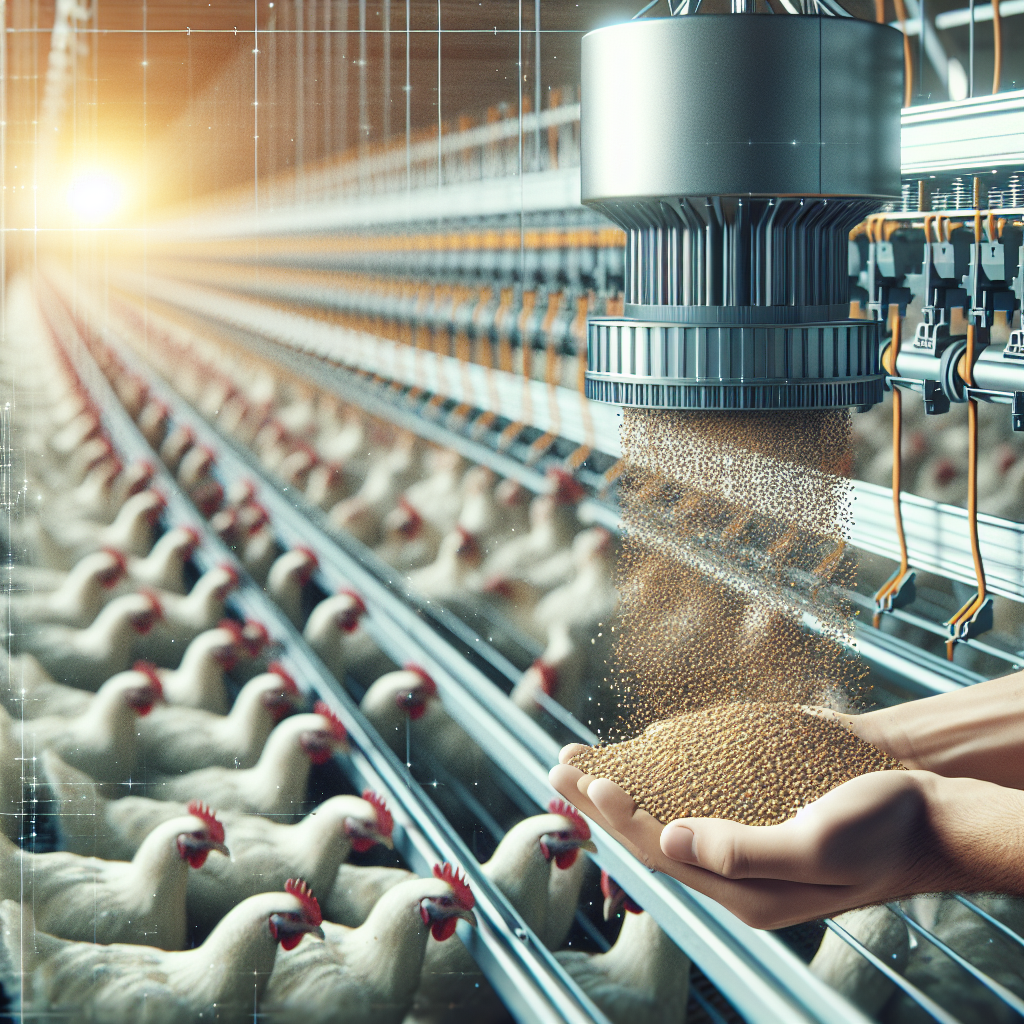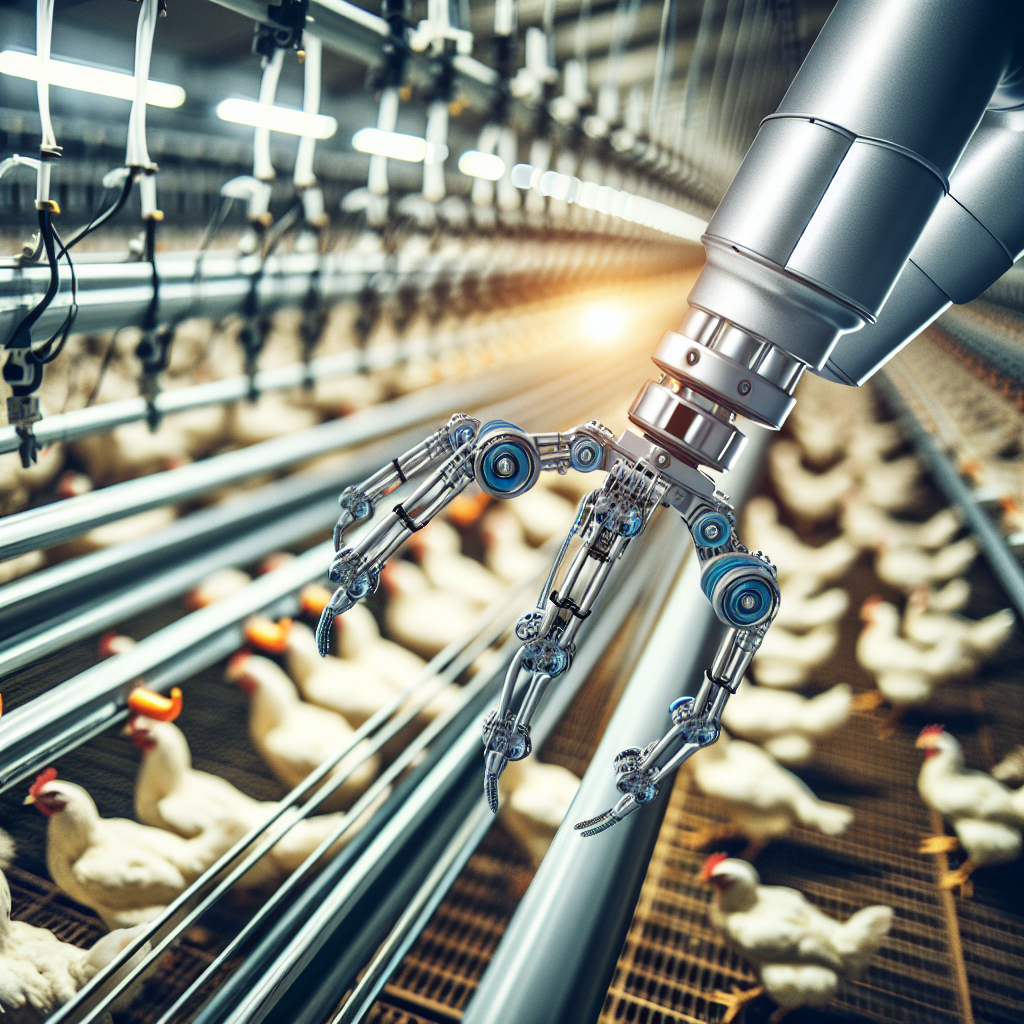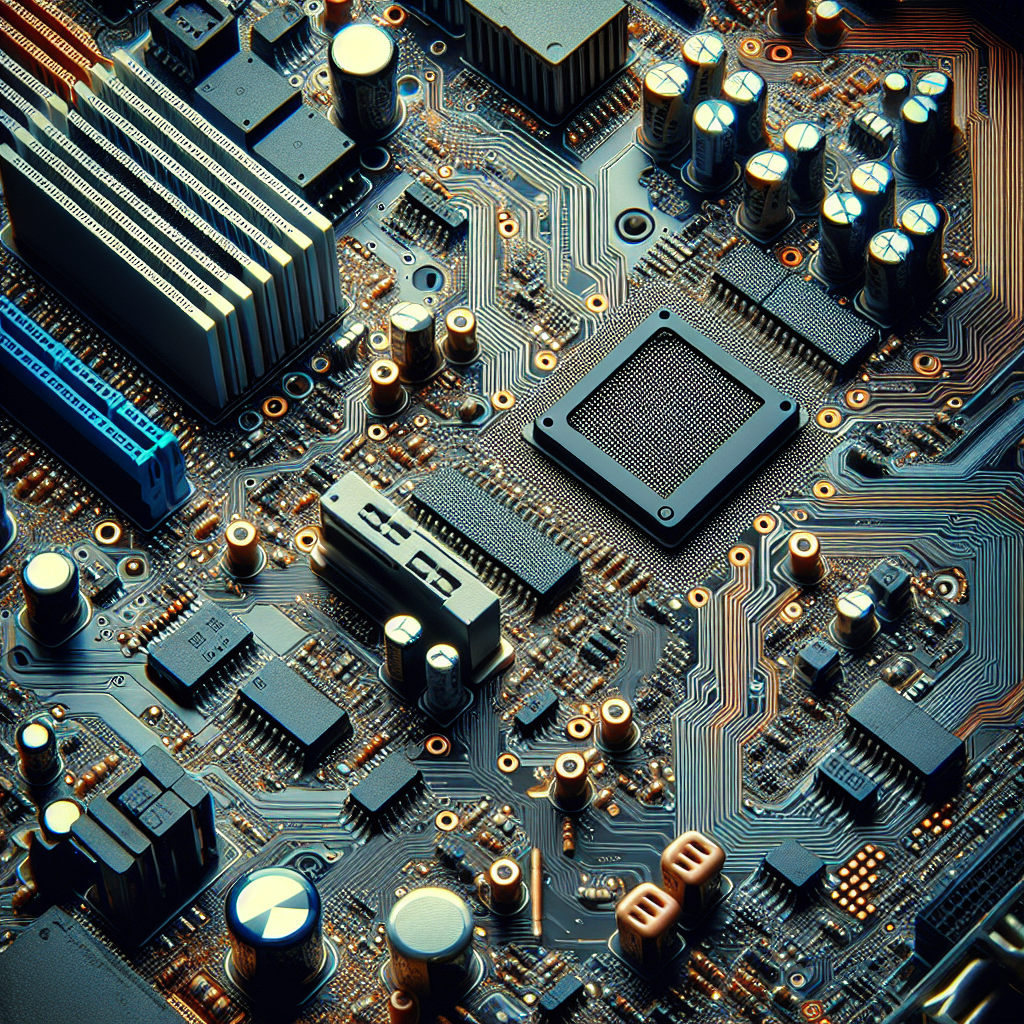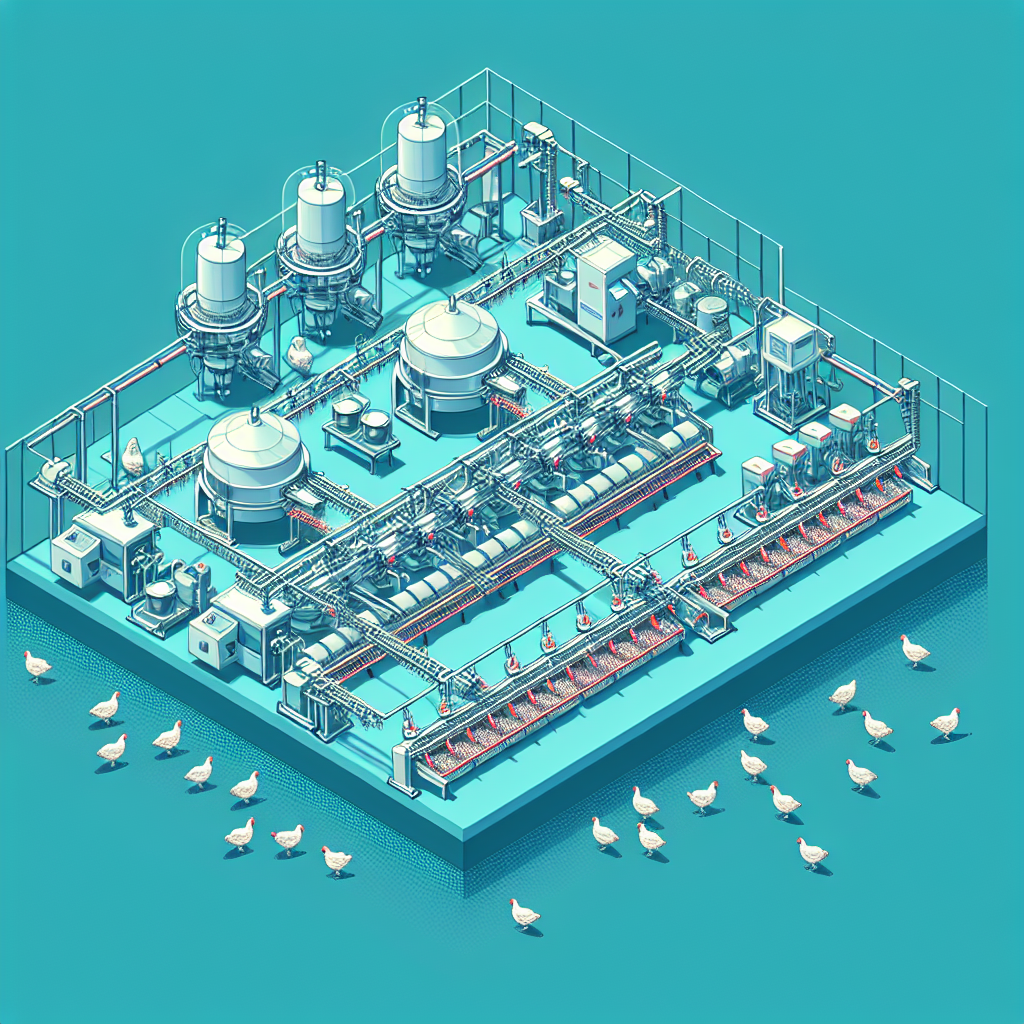In today’s increasingly digital age, the role of technology in optimizing efficiency and reducing costs for various industries cannot be understated. The same can be said for the poultry farming sector, where innovative technological solutions have emerged as game-changers, revolutionizing the overall operational costs. By streamlining processes, automating tedious tasks, and enhancing data analysis capabilities, these tech solutions have not only resulted in cost savings but also improved productivity and profitability in the poultry farming world.
Improving Efficiency
Automated Feeding Systems
Implementing automated feeding systems can greatly improve the efficiency of a poultry farm. These systems are designed to accurately and automatically distribute the right amount of feed to each bird, reducing the time and effort required for manual feeding. With automated feeding systems, you can ensure that all birds are receiving the necessary nutrition, leading to healthier and more productive flocks. Additionally, these systems can be programmed to feed the birds at specific times, optimizing their feeding schedule and minimizing waste.
Automated Watering Systems
Water is essential for the well-being and productivity of poultry, and automated watering systems can greatly simplify the process of providing water to the birds. These systems ensure constant access to clean water by automatically refilling the water reservoirs when needed. This eliminates the need for manual water checks and refills throughout the day, saving valuable time and effort. By consistently providing clean water, automated watering systems can also contribute to better bird health and performance.
Climate Control Systems
Maintaining the optimal temperature and humidity levels is crucial for the well-being of poultry and is often a challenging task for farmers. However, with the implementation of climate control systems, this process can be automated and streamlined. These systems utilize sensors and actuators to monitor and adjust temperature, ventilation, and humidity levels within the poultry house. By maintaining an optimal environment, these systems can help reduce stress and improve bird growth and productivity.
Egg Collection and Sorting Systems
Efficient egg collection and sorting are vital for maximizing productivity in a poultry farm. Automated egg collection systems are designed to gather eggs from the nesting areas without the need for manual intervention. These systems use conveyors, rollers, and sensors to ensure gentle handling of the eggs, minimizing the risk of damage. Additionally, automated egg sorting systems can accurately grade and sort the eggs based on their weight, size, and quality, reducing the labor-intensive task of manual sorting. By automating these processes, farmers can save time, reduce labor costs, and improve overall efficiency.
Reducing Labor Costs
Robotic Feeding and Watering Systems
Robotic feeding and watering systems take automation to the next level by completely eliminating the need for human involvement in these tasks. These advanced systems utilize robotic arms and sensors to accurately dispense feed and water to the poultry. With precise control and monitoring capabilities, these systems can ensure that each bird receives the right amount of feed and water. By reducing the need for manual labor, farmers can significantly cut down on labor costs and allocate resources to other important tasks.
Automated Cleaning Systems
Maintaining cleanliness and hygiene in a poultry farm is essential for preventing disease outbreaks and optimizing bird health. Automated cleaning systems can significantly reduce the time and effort required for cleaning the poultry house. These systems utilize high-pressure water jets and automated brushes to efficiently clean floors, walls, and equipment. By automating this labor-intensive task, farmers can save on labor costs and ensure a clean and healthy environment for the birds.
Automated Egg Collection Systems
Automated egg collection systems not only simplify the process of gathering eggs but also contribute to reducing labor costs in a poultry farm. These systems use conveyor belts or suction cups to gently collect eggs from the nesting areas, eliminating the need for manual egg collection. The collected eggs are then automatically transported to the sorting and packaging areas, further streamlining the process. By automating egg collection, farmers can save time, reduce labor expenses, and improve overall productivity.
Monitoring and Control Software
Monitoring and control software can greatly enhance the efficiency of a poultry farm by providing real-time data and control over various systems. These software solutions integrate with the automated systems in the farm, such as feeding, watering, and climate control systems, and provide farmers with detailed insights and control options. By closely monitoring and analyzing data on bird health, feed consumption, and environmental conditions, farmers can make informed decisions and optimize their farming practices. This can ultimately lead to reduced labor costs and improved operational efficiency.
Minimizing Feed Waste
Precision Feeding Systems
Precision feeding systems enable accurate and precise control over the amount and composition of the feed provided to poultry. These systems utilize automated feed dispensers and sensors to precisely measure and deliver the required amount of feed to each bird. By avoiding overfeeding or underfeeding, precision feeding systems can reduce feed waste and optimize the feed conversion ratio. This not only leads to cost savings but also ensures the birds receive the right nutrition for their growth and performance.
Real-time Monitoring of Feed Consumption
Real-time monitoring of feed consumption is crucial for minimizing feed waste in a poultry farm. By implementing sensors and data collection systems, farmers can continuously monitor the amount of feed consumed by the birds. This data can then be analyzed to identify any anomalies or inefficiencies in feed consumption. By detecting and addressing issues promptly, farmers can minimize feed waste and optimize their feed management practices.
Automated Feed Delivery Systems
Automated feed delivery systems streamline the process of delivering feed to poultry by eliminating the need for manual labor. These systems use conveyors or pneumatic tubes to transport feed from the storage area to the feeding systems in the poultry house. By automating this process, farmers can save time, reduce feed spillage and contamination, and ensure consistent and efficient feed delivery. This contributes to minimizing feed waste and optimizing feed utilization in the farm.
Optimizing Energy Consumption
Smart Lighting Systems
Smart lighting systems enable efficient control and management of lighting in the poultry house. These systems utilize sensors and automation technology to adjust lighting levels based on the birds’ needs and the time of day. By providing the right amount and quality of light, farmers can optimize energy consumption and create a comfortable and productive environment for the birds. Additionally, smart lighting systems can be programmed to simulate natural lighting patterns, which can have positive effects on bird behavior and performance.
Energy-Efficient Heating and Cooling Systems
Heating and cooling are major energy-consuming processes in a poultry farm. Implementing energy-efficient heating and cooling systems can significantly reduce energy consumption and operational costs. These systems utilize advanced technologies such as heat pumps, energy-recovery ventilation, and insulation to optimize energy utilization. By maintaining the desired temperature range without unnecessary energy expenditure, farmers can achieve substantial cost savings and reduce their carbon footprint.
Automated Ventilation Systems
Proper ventilation is crucial for maintaining optimal air quality and temperature in the poultry house. Automated ventilation systems use sensors to continuously monitor the environmental conditions and adjust airflow accordingly. By efficiently controlling ventilation rates and air exchange, these systems can optimize energy consumption while ensuring a healthy and comfortable environment for the birds. Automated ventilation systems also contribute to reducing moisture levels and preventing the buildup of harmful gases, further enhancing bird health and welfare.
Improving Disease Management
Real-time Monitoring of Poultry Health
Real-time monitoring of poultry health is essential for early disease detection and effective disease management. By implementing sensor-based monitoring systems, farmers can continuously monitor vital parameters such as body temperature, activity levels, and feed and water consumption. Any significant deviations from normal values can be promptly identified, allowing farmers to take necessary actions to prevent the spread of disease. By catching and addressing health issues early, farmers can minimize the impact of diseases and reduce the associated costs.
Early Disease Detection Systems
Early disease detection systems utilize advanced technologies such as thermal imaging and computer vision to identify potential health issues in poultry. These systems can detect signs of sickness or distress based on visual cues or temperature variations. By alerting farmers to possible health problems at an early stage, early disease detection systems enable timely intervention and treatment, minimizing the spread of diseases and saving the affected birds. Ultimately, these systems contribute to improved disease management and reduced losses for poultry farmers.
Automated Vaccination Systems
Vaccination is a vital component of disease prevention in poultry farms. Automated vaccination systems offer precise and efficient delivery of vaccines, eliminating the need for manual handling and administration. These systems use automated injection mechanisms or spray nozzles to accurately vaccinate the birds. By ensuring consistent and accurate vaccination, farmers can enhance the effectiveness of their disease prevention strategies and minimize the risk of disease outbreaks. Automated vaccination systems can also save labor costs and reduce the stress on birds during the vaccination process.
Streamlining Data Management
Farm Management Software
Farm management software provides a centralized platform for monitoring and managing various aspects of a poultry farm. These software solutions integrate data from different systems and processes, including feeding, watering, climate control, and health monitoring. By consolidating and organizing data, farmers can gain valuable insights into their farm’s performance and make data-driven decisions. Farm management software also simplifies record keeping, planning, and reporting tasks, saving time and improving overall operational efficiency.
Internet of Things (IoT) Integration
Internet of Things (IoT) integration enables seamless communication and data exchange between different devices and systems in a poultry farm. By connecting sensors, actuators, and software applications, farmers can achieve real-time monitoring, control, and automation of various farm processes. IoT integration allows for remote monitoring and control, enabling farmers to keep track of their farm’s performance and make necessary adjustments from anywhere. This technology streamlines data management, improves operational efficiency, and enhances decision-making capabilities.
Data Analytics and Reporting Tools
Data analytics and reporting tools enable farmers to gain valuable insights from the vast amount of data generated by their poultry farm. These tools use advanced algorithms and machine learning techniques to analyze data and identify patterns, trends, and anomalies. By leveraging these insights, farmers can optimize their farming practices, identify potential issues, and make informed decisions. Reporting tools also simplify the process of generating reports and sharing information with stakeholders, improving communication and facilitating informed decision-making.
Enhancing Biosecurity Measures
Automated Entry Control Systems
Maintaining strict biosecurity measures is crucial for preventing the introduction and spread of diseases in a poultry farm. Automated entry control systems help enforce biosecurity protocols by controlling access to the farm premises. These systems use electronic key cards or biometric authentication to ensure that only authorized personnel can enter restricted areas. By minimizing the risk of unauthorized entry, farmers can reduce the potential for disease transmission and improve overall biosecurity.
Hygiene and Sanitation Monitoring Systems
Hygiene and sanitation monitoring systems play a vital role in ensuring a clean and disease-free environment in a poultry farm. These systems utilize sensors and cameras to monitor hygiene practices, such as handwashing, disinfection, and waste management. By providing real-time feedback and reminders, hygiene and sanitation monitoring systems promote adherence to biosecurity protocols and good hygiene practices. This helps prevent the introduction and spread of diseases, protecting bird health and reducing the risk of costly disease outbreaks.
Quality Control Systems
Quality control systems are essential for ensuring the safety and quality of poultry products. These systems utilize sensors, cameras, and automated processes to monitor and control various quality parameters, such as product weight, appearance, and packaging integrity. By implementing automated quality control systems, farmers can minimize the risk of producing and delivering substandard products. This not only improves customer satisfaction but also reduces the financial losses associated with product recalls or rejections.
Ensuring Regulatory Compliance
Automated Recordkeeping Systems
Regulatory compliance is a critical aspect of operating a poultry farm. Automated recordkeeping systems simplify the process of documenting and managing farm-related information, ensuring compliance with regulatory requirements. These systems digitize and centralize records, including vaccination schedules, feed and medication usage, and animal health data. By automating recordkeeping, farmers can efficiently track and retrieve information, reducing the risk of errors and omissions. This promotes transparency, facilitates audits, and enables farmers to demonstrate compliance with regulatory standards.
Traceability and Labeling Systems
Traceability and labeling systems enable farmers to track and trace their poultry products throughout the supply chain. By implementing these systems, farmers can record and store information about product origin, processing, and distribution. This allows for effective recall management in case of product quality or safety issues. Additionally, traceability and labeling systems help meet consumer demands for transparency and enable farmers to comply with labeling regulations, providing accurate and reliable information to consumers.
Risk Assessment and Compliance Software
Risk assessment and compliance software helps poultry farmers identify and manage potential risks and ensure compliance with industry standards and regulations. These software solutions provide tools for assessing and mitigating risks related to biosecurity, food safety, environmental impact, and labor practices. By conducting regular risk assessments and implementing appropriate control measures, farmers can reduce the likelihood of incidents and ensure compliance with legal and ethical requirements. This contributes to the long-term sustainability and profitability of the poultry farm.
Improving Animal Welfare
Automated Environmental Enrichment Systems
Animal welfare is an increasingly important aspect of poultry farming, and automated environmental enrichment systems can play a significant role in improving the well-being of the birds. These systems provide stimuli and activities that simulate the natural environment, promoting natural behaviors and reducing stress. Examples of automated environmental enrichment systems include perches, nest boxes, and environmental enrichment devices. By implementing these systems, farmers can enhance animal welfare, reduce the risk of behavior-related issues, and improve the overall health and productivity of their flocks.
Real-time Monitoring of Poultry Behavior
Real-time monitoring of poultry behavior allows farmers to gain insights into the well-being and health of the birds. Sensor-based systems can track behaviors such as feeding, drinking, and activity levels, providing valuable information about the birds’ overall health and welfare. By closely monitoring poultry behavior, farmers can promptly identify any signs of distress or abnormal behavior, facilitating early intervention and preventive measures. This helps improve the welfare and productivity of the birds and enhances the overall sustainability of the poultry farm.
Animal Health Tracking Systems
Animal health tracking systems enable farmers to record and track individual bird health information throughout their lifecycle. By using identification tags or electronic chips, farmers can collect and store data on each bird’s health history, treatments received, and performance indicators. This information allows for targeted health management, early detection of diseases or health issues, and informed decision-making. Animal health tracking systems contribute to improving the welfare of the birds, reducing unnecessary treatments, and optimizing the overall health and productivity of the flock.
Facilitating Supply Chain Management
Automated Inventory Management Systems
Efficient inventory management is vital for ensuring a smooth and uninterrupted supply chain in a poultry farm. Automated inventory management systems enable farmers to accurately track and manage their feed, medication, and other essential supplies. By implementing these systems, farmers can reduce the risk of stockouts or overstocking, optimize inventory levels, and streamline the procurement process. This improves operational efficiency, minimizes waste, and ensures the availability of necessary resources for the smooth functioning of the poultry farm.
Demand Forecasting and Planning Tools
Demand forecasting and planning tools help farmers anticipate market demand and plan their production accordingly. By analyzing historical data, market trends, and customer preferences, farmers can estimate future demand for their poultry products. This enables them to optimize production levels, adjust pricing strategies, and make informed decisions about resource allocation. By aligning their production with market demand, farmers can minimize waste, maximize profitability, and maintain a stable and consistent supply of high-quality poultry products.
Supply Chain Integration Platforms
Supply chain integration platforms facilitate seamless communication and collaboration between different stakeholders in the poultry supply chain. These platforms enable real-time data exchange and visibility across the entire supply chain, from hatcheries and farms to processing plants and retailers. By integrating information on inventory levels, production schedules, transportation, and customer orders, farmers can streamline supply chain operations, reduce lead times, and improve coordination. Supply chain integration platforms enhance efficiency, optimize logistics, and contribute to the overall success of the poultry farm.
In conclusion, the implementation of technology solutions in a poultry farm can have a significant impact on improving operational efficiency and reducing costs. Automated systems for feeding, watering, climate control, and egg collection streamline processes, save time, and optimize resource utilization. Precision feeding, real-time monitoring, and automated delivery systems minimize feed waste and ensure optimal nutrition. Smart lighting, energy-efficient heating and cooling, and automated ventilation systems optimize energy consumption. Real-time monitoring, early disease detection, and automated vaccination systems improve disease management. Farm management software, IoT integration, and data analytics enhance data management and decision-making. Automated entry control, hygiene monitoring, and quality control systems enhance biosecurity measures. Automated recordkeeping, traceability, and compliance software ensure regulatory compliance. Automated environmental enrichment systems, real-time behavior monitoring, and animal health tracking enhance animal welfare. Finally, automated inventory management, demand forecasting, and supply chain integration platforms facilitate efficient supply chain management. By embracing these technology solutions, poultry farmers can enhance their productivity, profitability, and sustainability.




